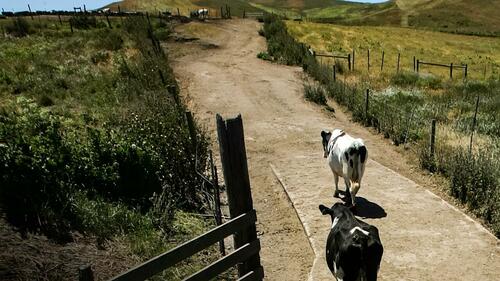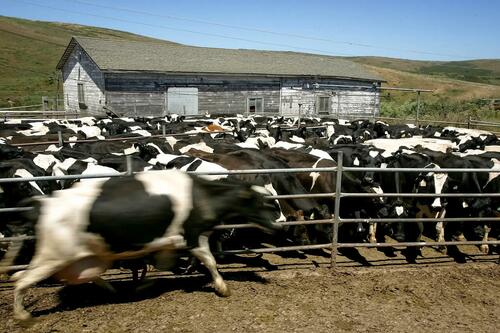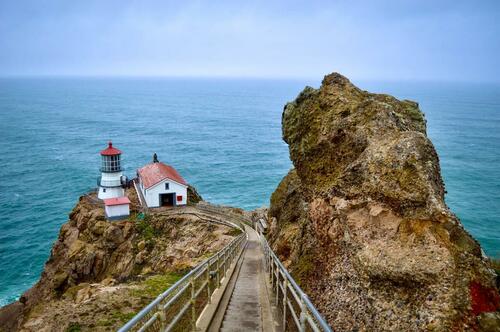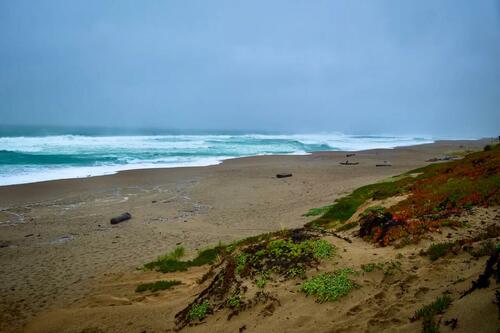![]()
End Of Ranching In Iconic California Community Signals Bigger War On Land Use In West
Authored by Beige Luciano-Adams via The Epoch Times (emphasis ours),
POINT REYES STATION, Calif.—The buffalo milk soft serve here is an open secret, found near the butcher’s counter at the back of the local market. Like everything else in this tiny farm town, nestled in the coastal grasslands about an hour north of San Francisco, it’s made with milk from a nearby dairy.
 Cows walk out to pasture after being milked at a dairy in Point Reyes Station, Calif., on June 12, 2007. Justin Sullivan/Getty Images
Cows walk out to pasture after being milked at a dairy in Point Reyes Station, Calif., on June 12, 2007. Justin Sullivan/Getty ImagesCalifornia’s Marin County is a pioneer in organic ranching, known for its gourmet cheeses, multi-generational dairies and pasture-raised beef. The legacy of more than 150 years of agricultural production is baked into its contemporary rural charms, which, along with the nearby Point Reyes National Seashore, make it a popular tourist destination.
It’s also a corner of the country where locals tend to see ranching and environmentalism as symbiotic pursuits.
But after years of conflict among preservationists, ranchers, and the federal government, a recent deal to end most ranching—all of it organic—on the Seashore has incensed locals and revealed a deep chasm between competing visions of environmental stewardship.
The agreement between three environmental groups—the Resource Renewal Institute, the Center for Biological Diversity, and the Western Watersheds Project—the National Park Service, and the Point Reyes Seashore Ranchers Association saw 12 of 14 ranches on Point Reyes agree to cease ranching within 15 months.
On one side, preservationists say cattle and dairy ranching at Point Reyes has led to environmental degradation that threatens the future of the park and biodiversity in the state; on the other, family ranchers see themselves as stewards of the land, their practices as the future of conservation—and as a bulwark against the ravages of Big Ag.
As the Trump administration moves to roll back Biden-era reforms, the high-profile case has become a flashpoint in the broader fight over land use in the West—where the federal government owns nearly half of all public land, and where ranching is considered a living legacy, part of the cultural heritage that built the West itself.
Now, a congressional investigation and two new lawsuits against the park are giving hope to critics of the Point Reyes deal that a policy shift could again be on the table, making the future of the park anything but settled.
What’s at stake, insiders say, is more than the dozen family ranches set to leave the park by next year. The questions Point Reyes raises will determine more than the fate of the National Seashore.
Multiple Use Mandate
While national forests and lands overseen by the Bureau of Land Management have long been governed by a multiple-use mandate, which includes grazing, timber, resource extraction, and recreation, national parks are typically more focused on preservation.
Point Reyes, a spectacularly beautiful coastal peninsula where ranching predates the park itself by a century, is an unusual case—and one bound to attract scrutiny from activists who oppose ranching on public lands.
 A cow runs past a corral of cows waiting to be milked at the Kehoe Dairy in Point Reyes Station, Calif., on June 12, 2007. In a landmark January 2025 settlement, most ranching operations within Point Reyes National Seashore are set to end within 15 months, following a long legal battle between environmental groups and ranchers. Justin Sullivan/Getty Images
A cow runs past a corral of cows waiting to be milked at the Kehoe Dairy in Point Reyes Station, Calif., on June 12, 2007. In a landmark January 2025 settlement, most ranching operations within Point Reyes National Seashore are set to end within 15 months, following a long legal battle between environmental groups and ranchers. Justin Sullivan/Getty Images“ I’ve never seen a private grazing lease on public lands that wasn’t doing environmental damage, whether it’s to salmon or to sage grouse, it doesn’t matter what ecosystem you’re in,” said Jeff Miller, a senior conservation advocate with the Center for Biological Diversity, one of the organizations that sued the National Park Service over its ranching leases in 2014 and 2022, resulting in the current agreement.
In the West, damage from private cattle grazing leases is “immense,” Miller said, second only to logging. Preservationists cite water pollution, soil erosion, and habitat loss, among other concerns.
The organization has focused on the issue since its founding in 1989, routinely intervening with National Forest and Bureau of Land Management plans and suing over grazing leases in cases where there is explicit and documented environmental damage, Miller said.
Over the past several years, the Biden administration advanced an agenda broadly favorable to conservationists, with national monument expansions and an initiative to conserve 30 percent of the nation’s land and water by 2030, as well as the 2024 Public Lands rule that allows prioritizing conservation above established multiple uses.
The Trump White House has indicated its intent to rescind the Bureau of Land Management’s Public Lands Rule, a move lambasted by environmental groups, who argue the administration is ushering in an era of unrestrained exploitation.
Congressional Republicans contend Biden’s upending of the multiple use doctrine has been a disaster both for rural communities and the country, driving up housing prices in Western cities surrounded by federal land and gutting local economies.
“President Biden left America’s public lands and natural resources in a sorry state,” Rep. Tom Tiffany (R-Wis.) told the House Natural Resources Committee during a February hearing on restoring multiple use.
“For four long years President Biden and his federal land managers have abandoned the longstanding and previously uncontroversial principle of multiple use. Instead, they adopted top-down, preservationist schemes designed to placate extreme environmentalists.”
In the same hearing, Tim Canterbury, president of the Public Lands Council, an organization representing cattle and sheep producers who hold 22,000 grazing permits across the West, highlighted challenges for ranchers, and urged Congress and federal agencies to recognize public lands ranching as an essential part of the multi-use framework.
“I manage these lands and waters, and the wildlife and multiple uses they sustain, as if they were my own,” Canterbury said. He said the infrastructure, ecological stewardship and investments that ranchers provide benefit the public and environment, not just privately owned livestock.
“My family has managed the lands we utilize since 1879. Our commitment to these lands is baked into our way of life,” Canterbury said of his Colorado ranch operation, adding that “deep historical and ecological knowledge of the working landscape” are handed down through generations.
 Point Reyes Lighthouse in Inverness, Calif., on March 16, 2025. Keegan Billings/The Epoch Times
Point Reyes Lighthouse in Inverness, Calif., on March 16, 2025. Keegan Billings/The Epoch TimesIvan London, a senior attorney with the Mountain States Legal Foundation, which frequently intervenes pro-bono on behalf of ranchers facing challenges to their grazing permits, said regulatory interpretations may shift with the balance of power in Washington, but the law governing grazing rights hasn’t changed.
“Congress actually said, ‘Here are some priority uses of public land—grazing, timber, harvesting, mineral production.’ And that law hasn’t changed. But from administration to administration the various regulators find ways to read it differently,” London said, pointing to President Bill Clinton’s attempts to increase grazing fees in the 1990s, and President Joe Biden’s embrace of conservation easements.
“According to the Taylor Grazing Act—an actual law, unlike the conservation leases—grazing and ranching are the highest use of public lands,” London said. That regulations allowing conservation leases to “lock up land away from ranchers” might be ending under the Trump administration is “huge,” he said.
The Mountain States Legal Foundation in 2023 successfully intervened on behalf of Wyoming ranchers when the Center for Biological Diversity, the Western Watersheds Project, and other groups alleged that one of the oldest cattle drives in the country threatened grizzly bear populations in violation of the Endangered Species Act.
Recognized as a Traditional Cultural Property on the National Register of Historic Places, the Green River Drift cattle drive is still operated by descendants of families that homesteaded the area in the 19th century.
It’s a familiar narrative, often reduced in court to a zero-sum game between preserving either vulnerable animal or plant species, or prized human cultural practices with histories that pre-date the authority managing the lands.
The families in question, their lawyers argued, cared for the land longer and better than any agency or activist, their continued existence providing “124 years of evidence that ranchers are the real conservationists.”
In other cases, such as Santa Rosa Island—now part of California’s Channel Islands National Park—the outlines of which presaged the fate of Point Reyes, environmental activists have succeeded in bringing nearly a century of ranching to a close.
In 1986, the federal government purchased Vail & Vickers Ranch, run by four generations of cattle ranchers on what was known as “Cowboy Island.” In 1998, the last working island cattle ranch in the United States shuttered for good.
“Cowboys versus environmentalists” is a common tableau throughout the West, with infamous spectacles such as Nevada rancher Cliven Bundy’s militarized standoff with the federal government.
In Point Reyes, the fight has pitted environmentalist against environmentalist in one of the most liberal enclaves in the country, exposing an existential schism within the conservation movement.
Ranchers Say They Were Pressured
In a protracted battle over the park’s ranch management plan that culminated in lawsuits in 2016 and 2022, both ranchers and the organizations who sued the park service accuse the agency of bias.
After years of studies and thousands of public comments, the park service in 2021 decided to issue 20-year leases, finally following through on a 2012 directive. Environmentalists filed a new lawsuit, ranchers intervened on behalf of the park, and the parties entered private negotiations.
 Point Reyes North Beach in Marin County, Calif., on March 16, 2025. Keegan Billings/The Epoch Times
Point Reyes North Beach in Marin County, Calif., on March 16, 2025. Keegan Billings/The Epoch TimesBut the settlement, completed just before the Trump administration took office, was celebrated internally among Department of Interior senior staff as a “win” for the department, the park, and for conservation—a “nice one to go out on” in the final hours of the Biden administration, according to emails unearthed in a Freedom of Information Act Request and published on Substack.
“These emails prove they were totally in on it and celebrating this victory against ranching,” said Andrew Giacomini, a San Francisco attorney representing pro-bono more than 60 ranch workers and subtenants who are set to be displaced by the Point Reyes settlement.
Despite apparent neutrality, Giacomini accused the government of conspiring with the conservationist organizations, which brought in a third party to mediate a settlement behind closed doors, all in an effort to push out ranchers.
“They could have defended that lawsuit and won,” Giacomini said. Instead, he alleges, the park service entered secret negotiations, overturned the results of a public process, and kowtowed to a “handful of special interests.”
“It’s exactly as our lawsuit says. The way it was handled violates the law in multiple ways and it can’t stand.”
Even before the case begins moving through the courts, Giacomini said he thinks shifting priorities in the new administration may result in a reversal of the decision to end ranching at Point Reyes.
Miller, of the Center for Biological Diversity, said the idea of any collusion between his organization, fellow plaintiffs, and the park service is “absolute nonsense,” calling the park’s 2014 ranch management plan a “wish list” from the ranchers, developed in secret without input from conservationists or the public.
Particularly egregious to conservationists was a request to cull once-endangered tule elk herds, which compete with cattle for food during periods of drought.
“They rolled this thing out in 2014 and said, ‘Guess what? We’re going to shoot tule elk. We’re going to expand ranches, and we’re going to enshrine private commercial ranching forever in the park.’ That was the park service’s first bite at the apple,” Miller said.
“That is not conservation, that’s collusion with the ranchers, which is what the park service has been doing for half a century.”
The Department of the Interior and its National Park Service did not respond to inquiries.
Miller contends the park service “has never taken an environmental position in their entire history—we’ve had to sue them the entire way.”
The Center for Biological Diversity, he said, will intervene in two new lawsuits against the park: one brought by ranch workers set to be evicted due to the recent settlement, and another brought by remaining ranchers seeking to preserve agricultural use in the park. “We are not going to allow a settlement between them and Trump’s Department of Interior.”
But ranchers say they were pressured to accept the January settlement and keep quiet about the process, which they say was negotiated behind closed doors by The Nature Conservancy, a nonprofit powerhouse that raised a reported $30 million for the buyout. Once ranchers agreed to leave, the Park Service rezoned 16,000 acres of land originally set aside for ranching as a new Scenic Landscape Zone, and handed over management of it to the Conservancy.
In a March letter to the Center for Biological Diversity and other plaintiffs, Republican members of the House Committee on Natural Resources alleged a “lack of transparency surrounding the settlement,” as well as potential environmental and legal consequences. The lawmakers requested extensive discovery information.
Read the rest here…
Tyler Durden
Wed, 05/14/2025 – 21:45














